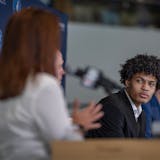In what may be a revolution in experiencing music, 19-year-old Russian pianist Osip Nikiforov is recording Chopin's Etude Op. 10, No. 1 without capturing any of its sound.
Instead, a sensor-equipped piano is recording the "data" of his performance, the mechanical movements when keys and foot pedals are pressed. Playing a piano generates thousands of data points. And when turned into digital ones and zeros, that data can be stored, transmitted on the Internet and even precisely replayed by another similarly equipped piano.
Nikiforov plays a Yamaha Corp. Disklavier owned by Hamline University music professor Stella Sick.
"These pianos are fantastic teaching tools," said Nikiforov. "You can correct things based on just listening to yourself. While you could do that with any recording, this one is even closer and more precise."
Sick says Nikiforov could use the piano to audition for another music school, saving travel and other costs. To promote Disklaviers, which cost $40,000 to $240,000, Yamaha has simplified Internet submission of recorded auditions. Last year, the company created a cloud storage website that allowed Disklavier performances to be shared among 18 U.S. universities and 28 private audition sites. George Litterst, a Massachusetts pianist and Yamaha consultant, said the network is expected to grow this year to 50 universities and 40 to 50 audition sites.
Nikiforov is already a beneficiary of Internet auditions. At age 13, he sent a recording from a similar Disklavier in Moscow to audition for an international music competition based in Minnesota. He won third place, and the experience brought him here to study.
'Reverse engineering'
Sick, also born in Russia, has a music doctorate from the University of Minnesota. But her teaching career has been altered by the technology.
"In addition to performing, I liked getting under the piano with the Yamaha technical guys to find out what they were doing, and they explained things to me," she said. She also discovered that by listening to the Disklavier's precise playback and watching the accompanying video of the player's movements, she could help students correct their mistakes.



